Sainsbury's Global Strategy Development and Implementation Report
VerifiedAdded on 2023/06/09
|17
|4641
|366
Report
AI Summary
This report delves into Sainsbury's global strategy development and implementation plan for entering the Singapore market. It begins with an introduction to internationalization and Sainsbury's background as the second-largest supermarket chain in the UK. The report then discusses strategic management, formulation, and implementation, emphasizing the importance of analyzing both the external and internal environments. External analysis includes PESTLE analysis (Political, Economic, Social, Technological, Legal, and Environmental factors) and Porter's Five Forces to assess industry dynamics and competitive forces in Singapore. Internal analysis employs the Resource-Based View (RBV) framework, examining tangible and intangible assets, competitive advantage, and sustainability through Porter's Diamond Model. The report also explores international strategy aspects, such as international, multi-domestic, global, and transnational strategies, recommending a transnational approach for Sainsbury's. Finally, the report touches on country selection criteria, mode of entry options (export, licensing, franchising), and concludes with key considerations for Sainsbury's successful expansion into Singapore.
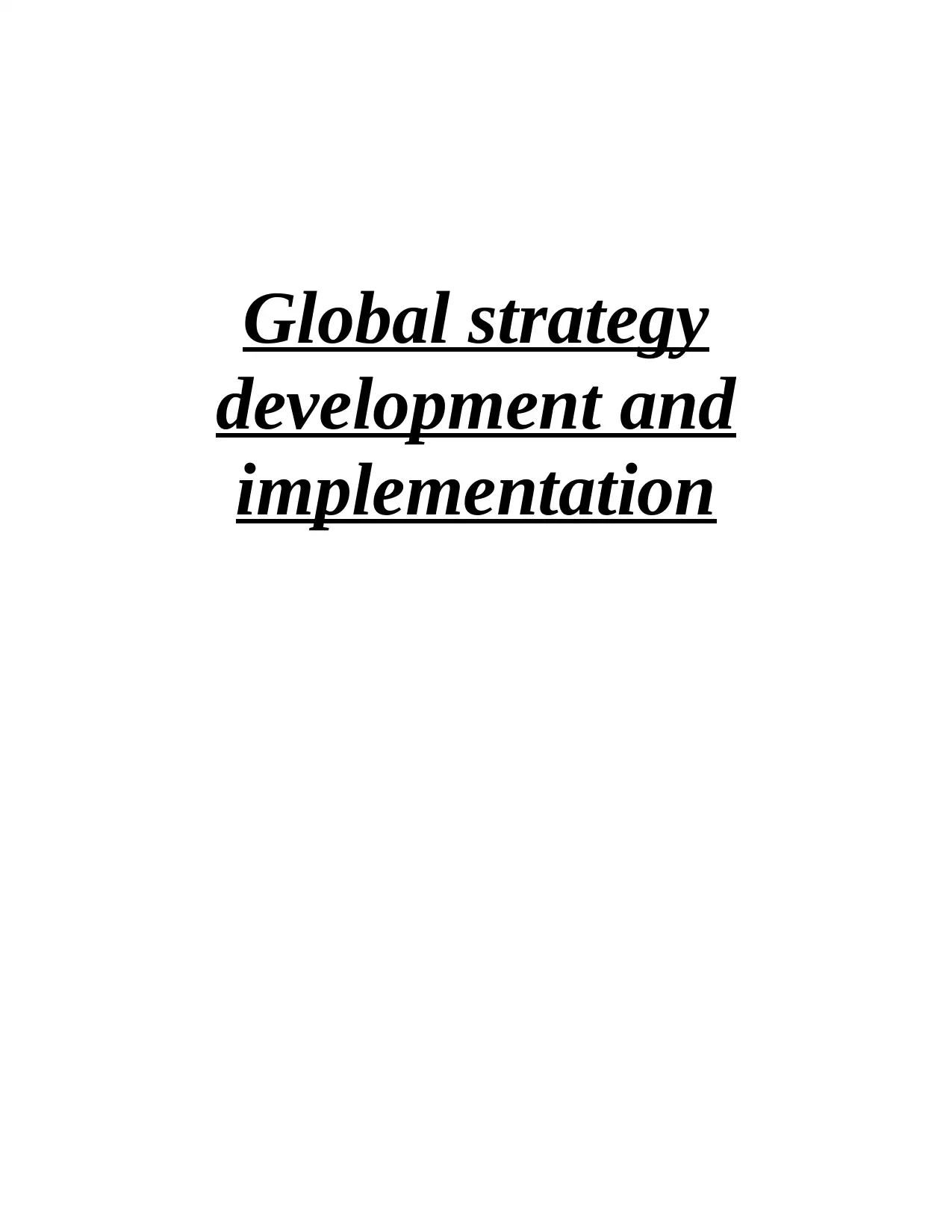
Global strategy
development and
implementation
development and
implementation
Paraphrase This Document
Need a fresh take? Get an instant paraphrase of this document with our AI Paraphraser
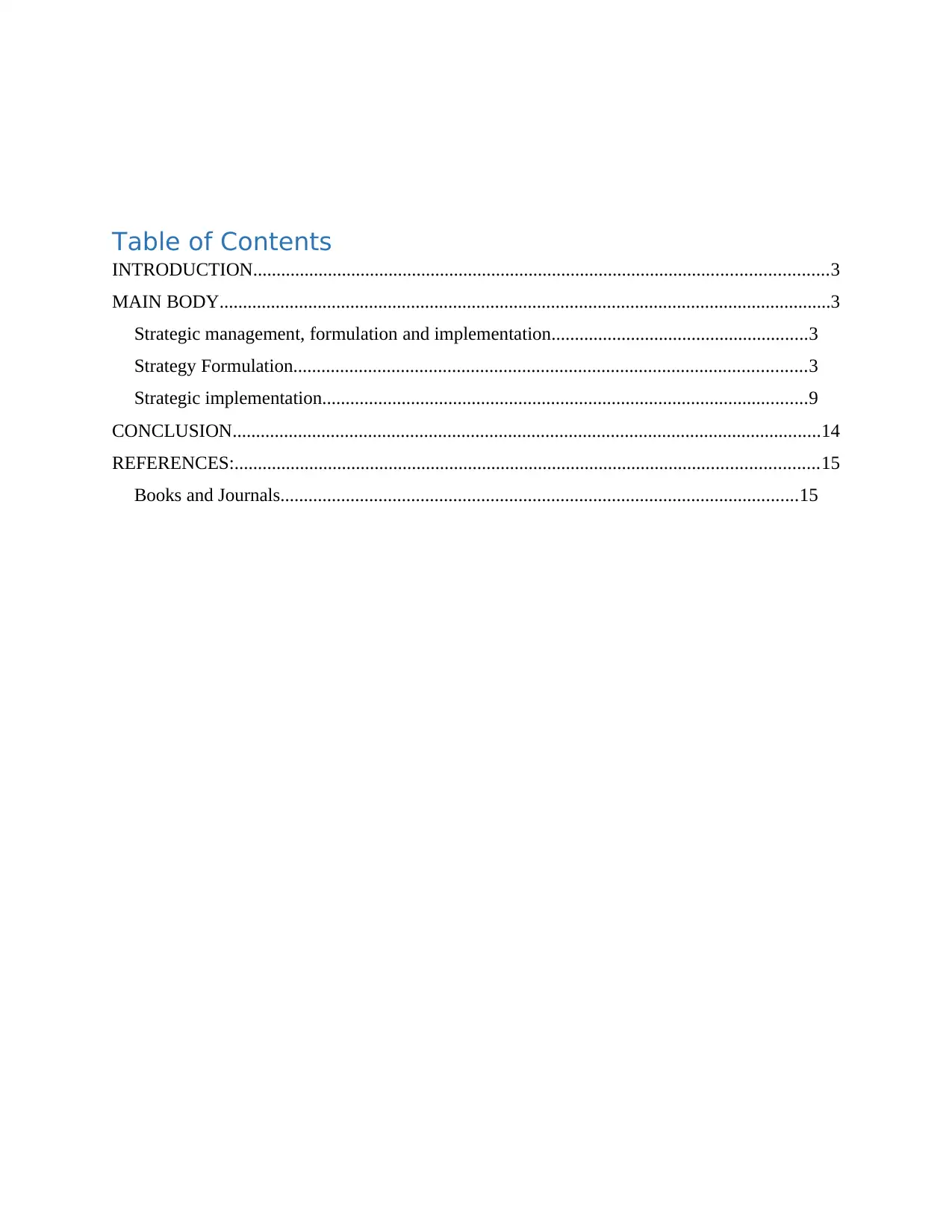
Table of Contents
INTRODUCTION...........................................................................................................................3
MAIN BODY...................................................................................................................................3
Strategic management, formulation and implementation.......................................................3
Strategy Formulation..............................................................................................................3
Strategic implementation........................................................................................................9
CONCLUSION..............................................................................................................................14
REFERENCES:.............................................................................................................................15
Books and Journals...............................................................................................................15
INTRODUCTION...........................................................................................................................3
MAIN BODY...................................................................................................................................3
Strategic management, formulation and implementation.......................................................3
Strategy Formulation..............................................................................................................3
Strategic implementation........................................................................................................9
CONCLUSION..............................................................................................................................14
REFERENCES:.............................................................................................................................15
Books and Journals...............................................................................................................15
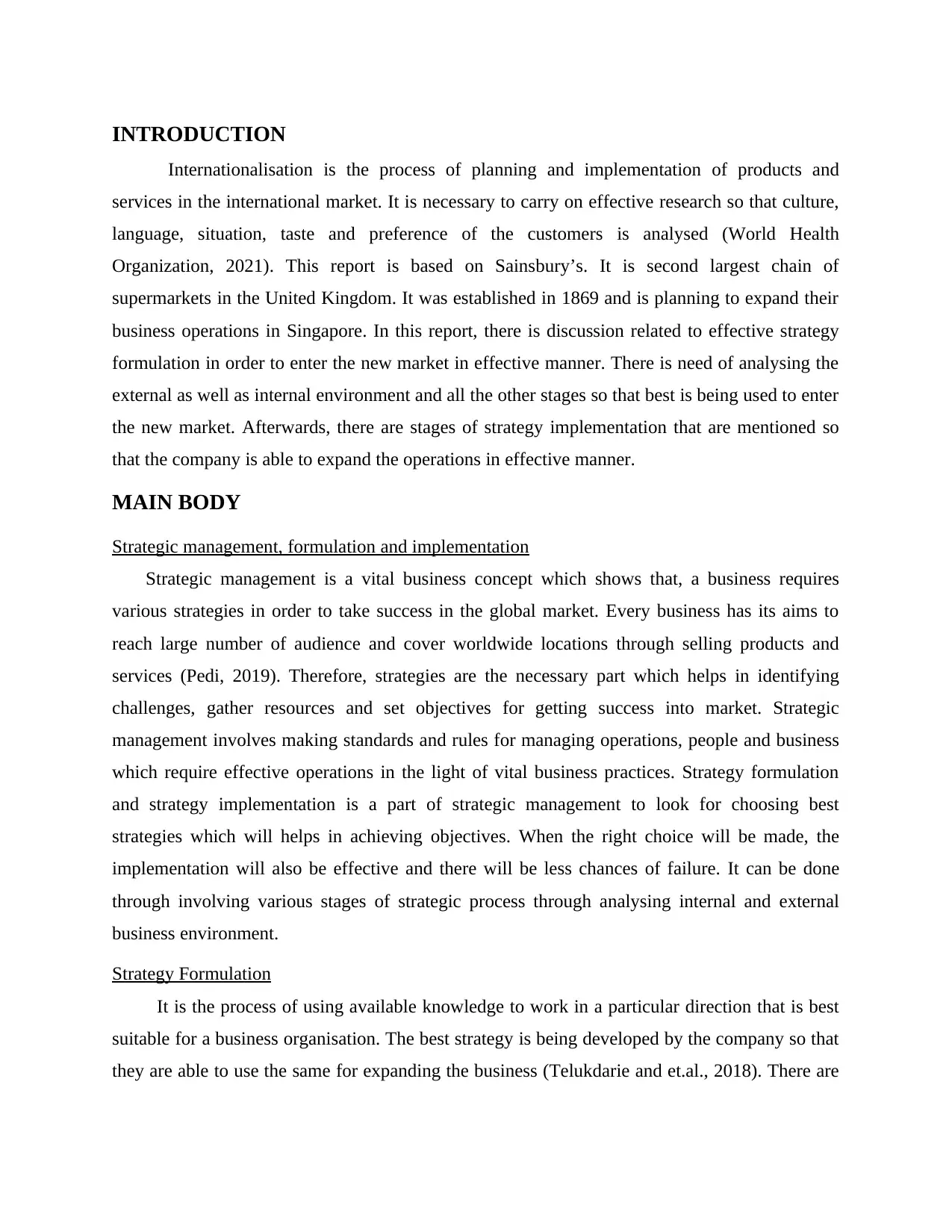
INTRODUCTION
Internationalisation is the process of planning and implementation of products and
services in the international market. It is necessary to carry on effective research so that culture,
language, situation, taste and preference of the customers is analysed (World Health
Organization, 2021). This report is based on Sainsbury’s. It is second largest chain of
supermarkets in the United Kingdom. It was established in 1869 and is planning to expand their
business operations in Singapore. In this report, there is discussion related to effective strategy
formulation in order to enter the new market in effective manner. There is need of analysing the
external as well as internal environment and all the other stages so that best is being used to enter
the new market. Afterwards, there are stages of strategy implementation that are mentioned so
that the company is able to expand the operations in effective manner.
MAIN BODY
Strategic management, formulation and implementation
Strategic management is a vital business concept which shows that, a business requires
various strategies in order to take success in the global market. Every business has its aims to
reach large number of audience and cover worldwide locations through selling products and
services (Pedi, 2019). Therefore, strategies are the necessary part which helps in identifying
challenges, gather resources and set objectives for getting success into market. Strategic
management involves making standards and rules for managing operations, people and business
which require effective operations in the light of vital business practices. Strategy formulation
and strategy implementation is a part of strategic management to look for choosing best
strategies which will helps in achieving objectives. When the right choice will be made, the
implementation will also be effective and there will be less chances of failure. It can be done
through involving various stages of strategic process through analysing internal and external
business environment.
Strategy Formulation
It is the process of using available knowledge to work in a particular direction that is best
suitable for a business organisation. The best strategy is being developed by the company so that
they are able to use the same for expanding the business (Telukdarie and et.al., 2018). There are
Internationalisation is the process of planning and implementation of products and
services in the international market. It is necessary to carry on effective research so that culture,
language, situation, taste and preference of the customers is analysed (World Health
Organization, 2021). This report is based on Sainsbury’s. It is second largest chain of
supermarkets in the United Kingdom. It was established in 1869 and is planning to expand their
business operations in Singapore. In this report, there is discussion related to effective strategy
formulation in order to enter the new market in effective manner. There is need of analysing the
external as well as internal environment and all the other stages so that best is being used to enter
the new market. Afterwards, there are stages of strategy implementation that are mentioned so
that the company is able to expand the operations in effective manner.
MAIN BODY
Strategic management, formulation and implementation
Strategic management is a vital business concept which shows that, a business requires
various strategies in order to take success in the global market. Every business has its aims to
reach large number of audience and cover worldwide locations through selling products and
services (Pedi, 2019). Therefore, strategies are the necessary part which helps in identifying
challenges, gather resources and set objectives for getting success into market. Strategic
management involves making standards and rules for managing operations, people and business
which require effective operations in the light of vital business practices. Strategy formulation
and strategy implementation is a part of strategic management to look for choosing best
strategies which will helps in achieving objectives. When the right choice will be made, the
implementation will also be effective and there will be less chances of failure. It can be done
through involving various stages of strategic process through analysing internal and external
business environment.
Strategy Formulation
It is the process of using available knowledge to work in a particular direction that is best
suitable for a business organisation. The best strategy is being developed by the company so that
they are able to use the same for expanding the business (Telukdarie and et.al., 2018). There are
⊘ This is a preview!⊘
Do you want full access?
Subscribe today to unlock all pages.

Trusted by 1+ million students worldwide
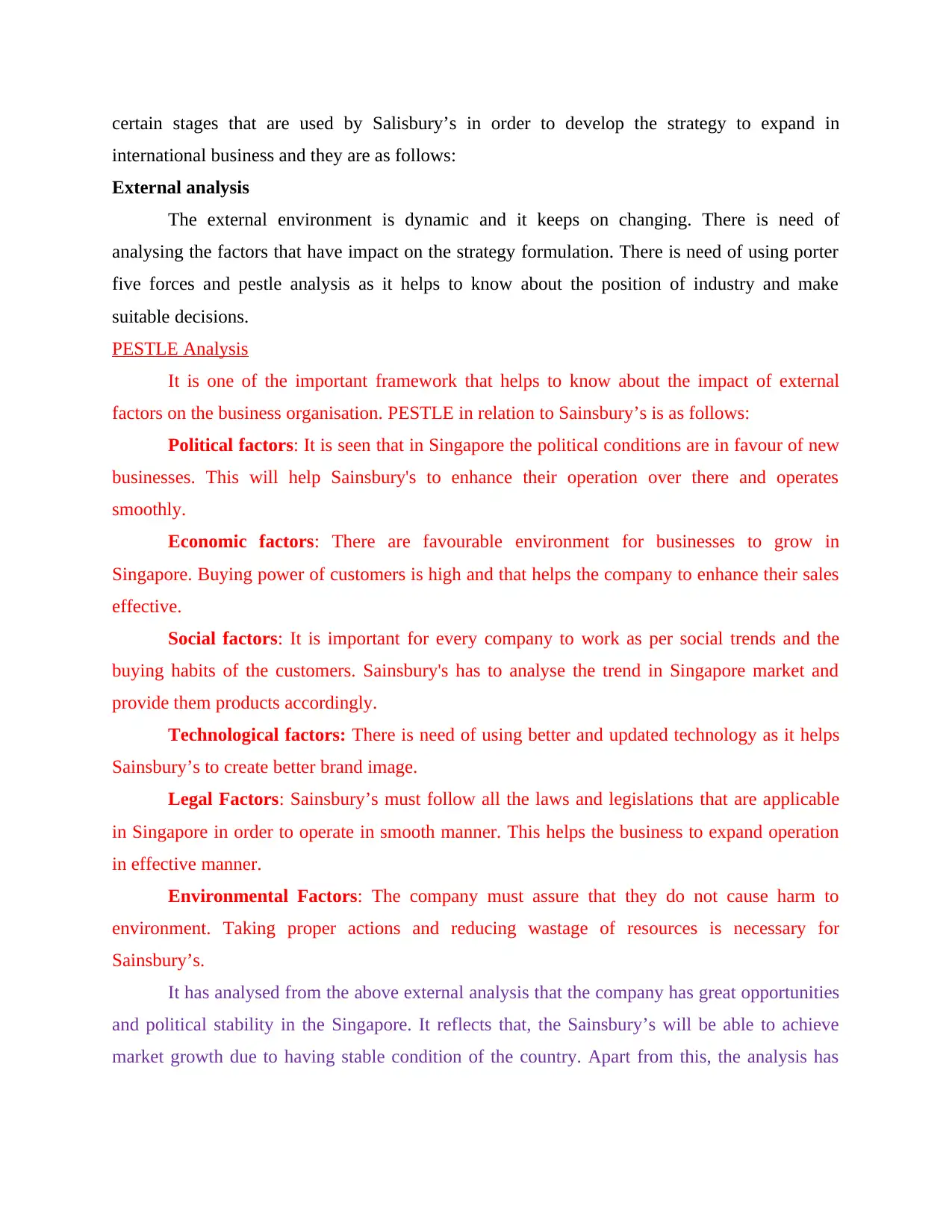
certain stages that are used by Salisbury’s in order to develop the strategy to expand in
international business and they are as follows:
External analysis
The external environment is dynamic and it keeps on changing. There is need of
analysing the factors that have impact on the strategy formulation. There is need of using porter
five forces and pestle analysis as it helps to know about the position of industry and make
suitable decisions.
PESTLE Analysis
It is one of the important framework that helps to know about the impact of external
factors on the business organisation. PESTLE in relation to Sainsbury’s is as follows:
Political factors: It is seen that in Singapore the political conditions are in favour of new
businesses. This will help Sainsbury's to enhance their operation over there and operates
smoothly.
Economic factors: There are favourable environment for businesses to grow in
Singapore. Buying power of customers is high and that helps the company to enhance their sales
effective.
Social factors: It is important for every company to work as per social trends and the
buying habits of the customers. Sainsbury's has to analyse the trend in Singapore market and
provide them products accordingly.
Technological factors: There is need of using better and updated technology as it helps
Sainsbury’s to create better brand image.
Legal Factors: Sainsbury’s must follow all the laws and legislations that are applicable
in Singapore in order to operate in smooth manner. This helps the business to expand operation
in effective manner.
Environmental Factors: The company must assure that they do not cause harm to
environment. Taking proper actions and reducing wastage of resources is necessary for
Sainsbury’s.
It has analysed from the above external analysis that the company has great opportunities
and political stability in the Singapore. It reflects that, the Sainsbury’s will be able to achieve
market growth due to having stable condition of the country. Apart from this, the analysis has
international business and they are as follows:
External analysis
The external environment is dynamic and it keeps on changing. There is need of
analysing the factors that have impact on the strategy formulation. There is need of using porter
five forces and pestle analysis as it helps to know about the position of industry and make
suitable decisions.
PESTLE Analysis
It is one of the important framework that helps to know about the impact of external
factors on the business organisation. PESTLE in relation to Sainsbury’s is as follows:
Political factors: It is seen that in Singapore the political conditions are in favour of new
businesses. This will help Sainsbury's to enhance their operation over there and operates
smoothly.
Economic factors: There are favourable environment for businesses to grow in
Singapore. Buying power of customers is high and that helps the company to enhance their sales
effective.
Social factors: It is important for every company to work as per social trends and the
buying habits of the customers. Sainsbury's has to analyse the trend in Singapore market and
provide them products accordingly.
Technological factors: There is need of using better and updated technology as it helps
Sainsbury’s to create better brand image.
Legal Factors: Sainsbury’s must follow all the laws and legislations that are applicable
in Singapore in order to operate in smooth manner. This helps the business to expand operation
in effective manner.
Environmental Factors: The company must assure that they do not cause harm to
environment. Taking proper actions and reducing wastage of resources is necessary for
Sainsbury’s.
It has analysed from the above external analysis that the company has great opportunities
and political stability in the Singapore. It reflects that, the Sainsbury’s will be able to achieve
market growth due to having stable condition of the country. Apart from this, the analysis has
Paraphrase This Document
Need a fresh take? Get an instant paraphrase of this document with our AI Paraphraser

also shown that environmental and economic factors need to consider while going to
international market. As it will have great impact on the company image in different market.
Porter five forces
This is used to understand about the industry and the forces that have impact on the
operations of Sainsbury’s. The discussion related to all the forces in regard to Sainsbury’s is as
follows:
Threat of new entrants: In retail sector, there are various firms that have established
strong position in the market. Sainsbury’s also want to expand their operations and enter the
market of Singapore (Ismail and et.al., 2022). There is high threat in the industry due to lack of
barriers of starting a new business.
Bargaining power of suppliers: In retail sector there are a lot of suppliers and this
reduces the bargaining power of suppliers. At the same time, Sainsbury’s will build good
relations with the customers so that they do not have to switch the suppliers and are able to get
the products of right time.
Bargaining power of buyers: The customers have high power due to the available
competitor present in the market (Olateju and et.al., 2022). They can switch to the other firms
selling similar products. It is seen that Sainsbury’s must give good offers and discounts so that
they are able to retain the customers and enhance their experience.
Threat of substitutes: There are a lot of substitute firms available in the market and due
to this reason they have high threat from substitutes. There is need of using better marketing by
Sainsbury’s so that they are able to attract the customers.
Rivalry among existing competitors: There are a lot of competitors in retail sector so
the Sainsbury’s will face high competition. The company must maintain quality of the products
in order to serve the customers effectively.
From this analysis, it has shown that the company may have great impact of the market
competition due to having high impact of retail industry. Therefore, Sainsbury’s have to analyse
strong position in order to remain competitive from new players. The availability of substitutes
will also affect the company position due to having wide varieties of product in retail industry.
Internal analysis
international market. As it will have great impact on the company image in different market.
Porter five forces
This is used to understand about the industry and the forces that have impact on the
operations of Sainsbury’s. The discussion related to all the forces in regard to Sainsbury’s is as
follows:
Threat of new entrants: In retail sector, there are various firms that have established
strong position in the market. Sainsbury’s also want to expand their operations and enter the
market of Singapore (Ismail and et.al., 2022). There is high threat in the industry due to lack of
barriers of starting a new business.
Bargaining power of suppliers: In retail sector there are a lot of suppliers and this
reduces the bargaining power of suppliers. At the same time, Sainsbury’s will build good
relations with the customers so that they do not have to switch the suppliers and are able to get
the products of right time.
Bargaining power of buyers: The customers have high power due to the available
competitor present in the market (Olateju and et.al., 2022). They can switch to the other firms
selling similar products. It is seen that Sainsbury’s must give good offers and discounts so that
they are able to retain the customers and enhance their experience.
Threat of substitutes: There are a lot of substitute firms available in the market and due
to this reason they have high threat from substitutes. There is need of using better marketing by
Sainsbury’s so that they are able to attract the customers.
Rivalry among existing competitors: There are a lot of competitors in retail sector so
the Sainsbury’s will face high competition. The company must maintain quality of the products
in order to serve the customers effectively.
From this analysis, it has shown that the company may have great impact of the market
competition due to having high impact of retail industry. Therefore, Sainsbury’s have to analyse
strong position in order to remain competitive from new players. The availability of substitutes
will also affect the company position due to having wide varieties of product in retail industry.
Internal analysis
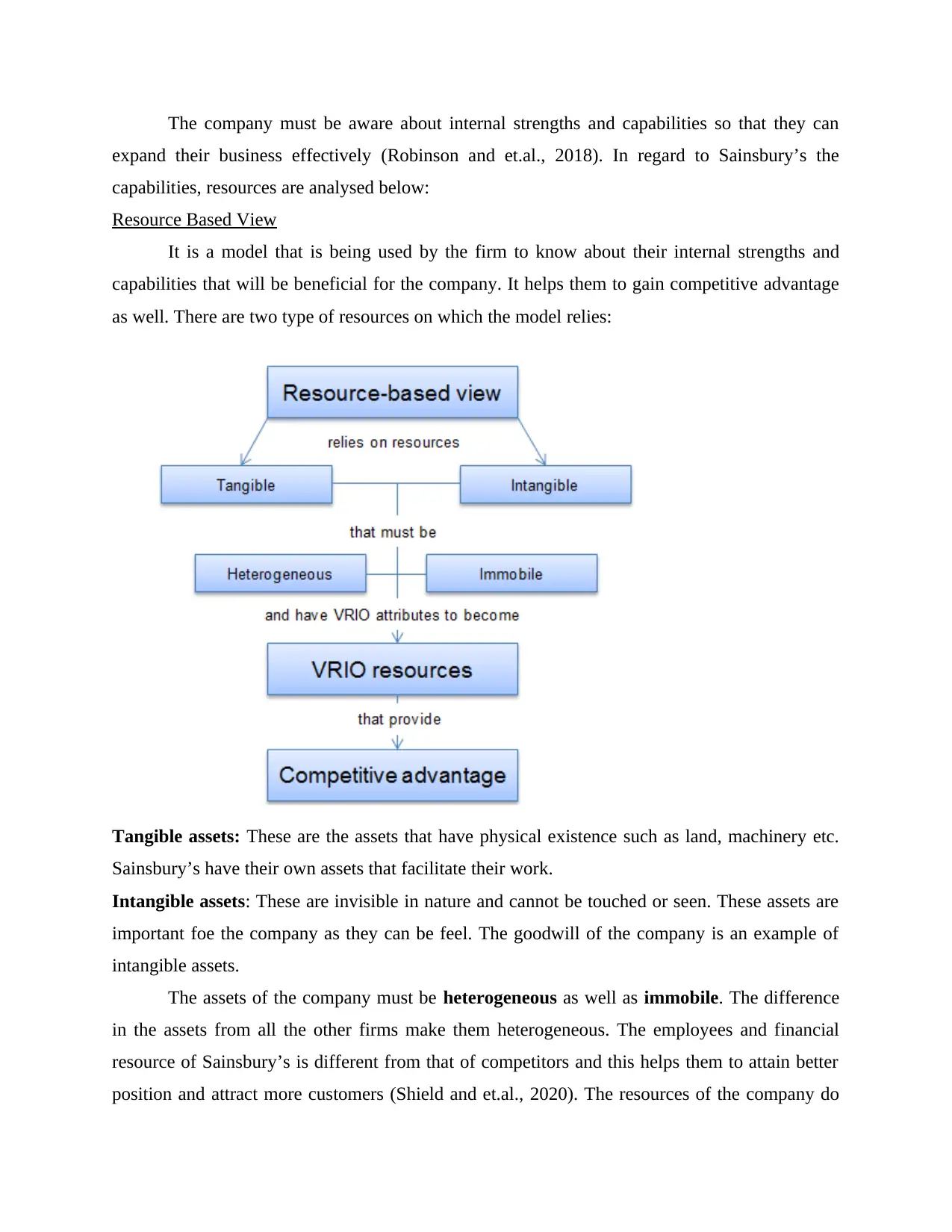
The company must be aware about internal strengths and capabilities so that they can
expand their business effectively (Robinson and et.al., 2018). In regard to Sainsbury’s the
capabilities, resources are analysed below:
Resource Based View
It is a model that is being used by the firm to know about their internal strengths and
capabilities that will be beneficial for the company. It helps them to gain competitive advantage
as well. There are two type of resources on which the model relies:
Tangible assets: These are the assets that have physical existence such as land, machinery etc.
Sainsbury’s have their own assets that facilitate their work.
Intangible assets: These are invisible in nature and cannot be touched or seen. These assets are
important foe the company as they can be feel. The goodwill of the company is an example of
intangible assets.
The assets of the company must be heterogeneous as well as immobile. The difference
in the assets from all the other firms make them heterogeneous. The employees and financial
resource of Sainsbury’s is different from that of competitors and this helps them to attain better
position and attract more customers (Shield and et.al., 2020). The resources of the company do
expand their business effectively (Robinson and et.al., 2018). In regard to Sainsbury’s the
capabilities, resources are analysed below:
Resource Based View
It is a model that is being used by the firm to know about their internal strengths and
capabilities that will be beneficial for the company. It helps them to gain competitive advantage
as well. There are two type of resources on which the model relies:
Tangible assets: These are the assets that have physical existence such as land, machinery etc.
Sainsbury’s have their own assets that facilitate their work.
Intangible assets: These are invisible in nature and cannot be touched or seen. These assets are
important foe the company as they can be feel. The goodwill of the company is an example of
intangible assets.
The assets of the company must be heterogeneous as well as immobile. The difference
in the assets from all the other firms make them heterogeneous. The employees and financial
resource of Sainsbury’s is different from that of competitors and this helps them to attain better
position and attract more customers (Shield and et.al., 2020). The resources of the company do
⊘ This is a preview!⊘
Do you want full access?
Subscribe today to unlock all pages.

Trusted by 1+ million students worldwide
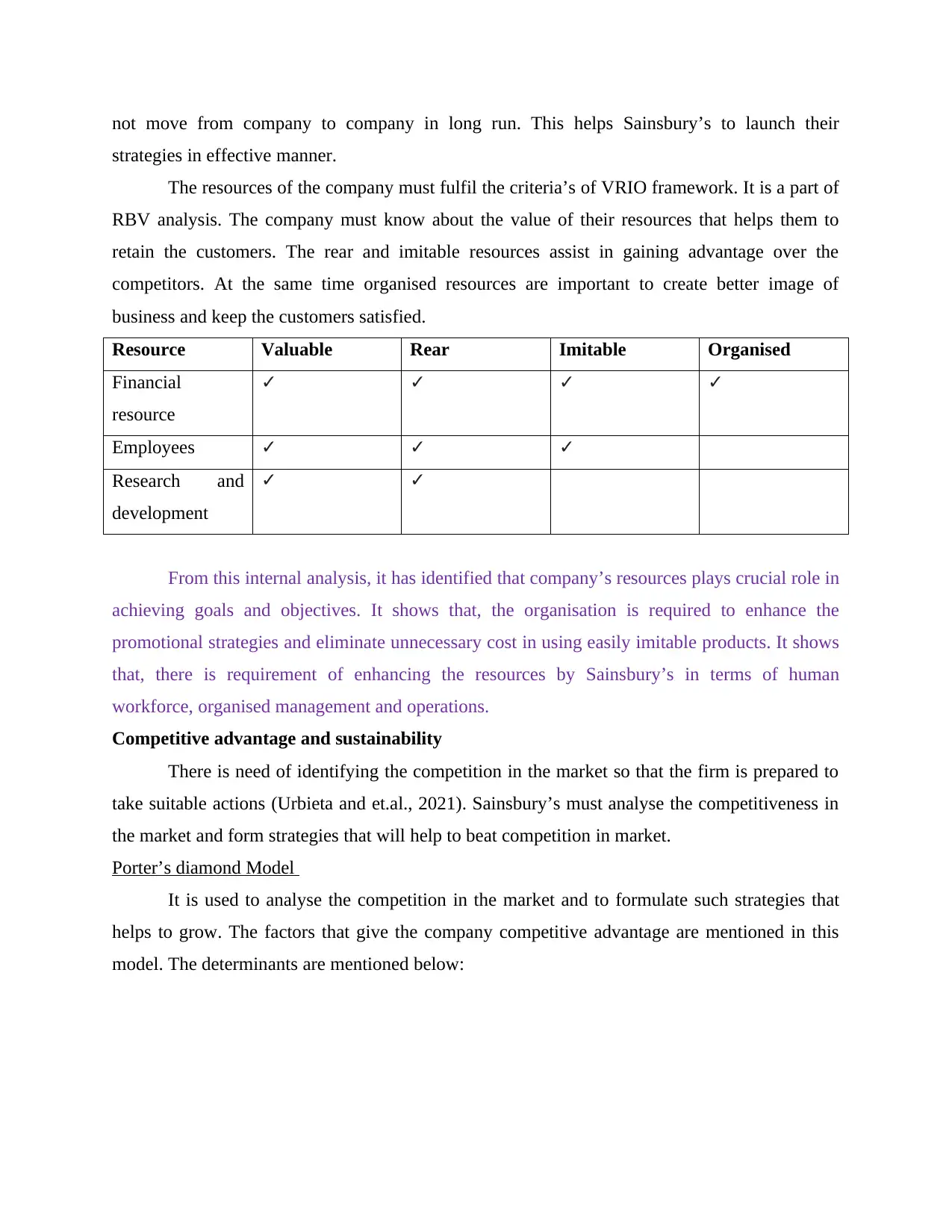
not move from company to company in long run. This helps Sainsbury’s to launch their
strategies in effective manner.
The resources of the company must fulfil the criteria’s of VRIO framework. It is a part of
RBV analysis. The company must know about the value of their resources that helps them to
retain the customers. The rear and imitable resources assist in gaining advantage over the
competitors. At the same time organised resources are important to create better image of
business and keep the customers satisfied.
Resource Valuable Rear Imitable Organised
Financial
resource
✓ ✓ ✓ ✓
Employees ✓ ✓ ✓
Research and
development
✓ ✓
From this internal analysis, it has identified that company’s resources plays crucial role in
achieving goals and objectives. It shows that, the organisation is required to enhance the
promotional strategies and eliminate unnecessary cost in using easily imitable products. It shows
that, there is requirement of enhancing the resources by Sainsbury’s in terms of human
workforce, organised management and operations.
Competitive advantage and sustainability
There is need of identifying the competition in the market so that the firm is prepared to
take suitable actions (Urbieta and et.al., 2021). Sainsbury’s must analyse the competitiveness in
the market and form strategies that will help to beat competition in market.
Porter’s diamond Model
It is used to analyse the competition in the market and to formulate such strategies that
helps to grow. The factors that give the company competitive advantage are mentioned in this
model. The determinants are mentioned below:
strategies in effective manner.
The resources of the company must fulfil the criteria’s of VRIO framework. It is a part of
RBV analysis. The company must know about the value of their resources that helps them to
retain the customers. The rear and imitable resources assist in gaining advantage over the
competitors. At the same time organised resources are important to create better image of
business and keep the customers satisfied.
Resource Valuable Rear Imitable Organised
Financial
resource
✓ ✓ ✓ ✓
Employees ✓ ✓ ✓
Research and
development
✓ ✓
From this internal analysis, it has identified that company’s resources plays crucial role in
achieving goals and objectives. It shows that, the organisation is required to enhance the
promotional strategies and eliminate unnecessary cost in using easily imitable products. It shows
that, there is requirement of enhancing the resources by Sainsbury’s in terms of human
workforce, organised management and operations.
Competitive advantage and sustainability
There is need of identifying the competition in the market so that the firm is prepared to
take suitable actions (Urbieta and et.al., 2021). Sainsbury’s must analyse the competitiveness in
the market and form strategies that will help to beat competition in market.
Porter’s diamond Model
It is used to analyse the competition in the market and to formulate such strategies that
helps to grow. The factors that give the company competitive advantage are mentioned in this
model. The determinants are mentioned below:
Paraphrase This Document
Need a fresh take? Get an instant paraphrase of this document with our AI Paraphraser

Firm strategy, structure and rivalry: This is dependent on the combination of
economic, social and political factors. Sainsbury’s make strong strategies that help them to attain
advantage over the rivalry. They work on differentiating their products that makes the operations
of business effective.
Demand Conditions: The demand for the retail products is high in the market. This is
the reason the company wants to expand the operations. By analysing the demand, the firm is
able to improvise their products constantly.
Factor conditions: It includes all those resources that are available in the nation for the company
(Tien and Ngoc, 2019). The basic resources include natural resources, labour and the advanced
resources include innovative technology and latest infrastructure. The company has to manage
them in order to attain competitive lead.
Related supporting industries: The success of one industry is dependent on the another.
The raw materials, transportation, e-commerce also have impact on the operations of
Sainsbury’s.
International aspects of strategy formulation
economic, social and political factors. Sainsbury’s make strong strategies that help them to attain
advantage over the rivalry. They work on differentiating their products that makes the operations
of business effective.
Demand Conditions: The demand for the retail products is high in the market. This is
the reason the company wants to expand the operations. By analysing the demand, the firm is
able to improvise their products constantly.
Factor conditions: It includes all those resources that are available in the nation for the company
(Tien and Ngoc, 2019). The basic resources include natural resources, labour and the advanced
resources include innovative technology and latest infrastructure. The company has to manage
them in order to attain competitive lead.
Related supporting industries: The success of one industry is dependent on the another.
The raw materials, transportation, e-commerce also have impact on the operations of
Sainsbury’s.
International aspects of strategy formulation
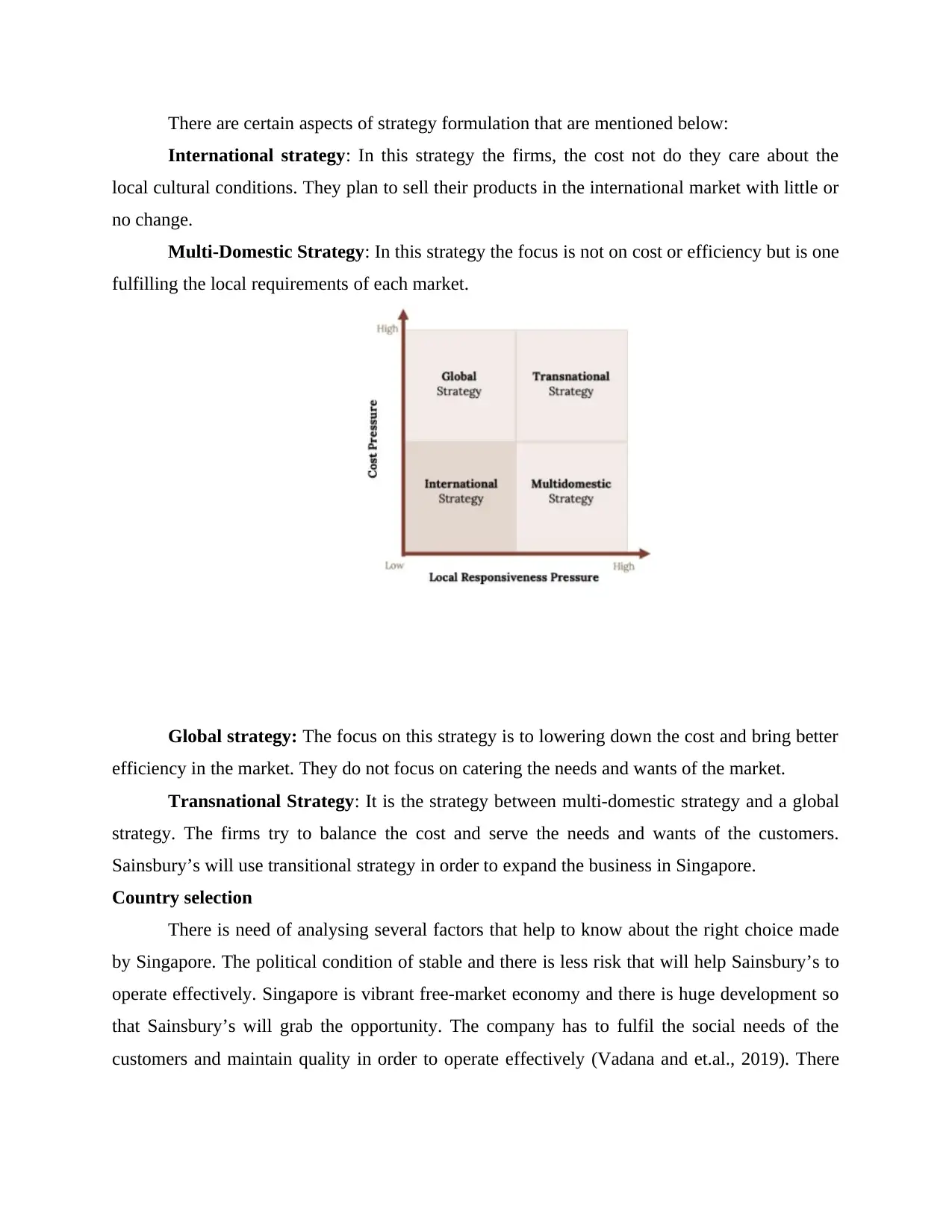
There are certain aspects of strategy formulation that are mentioned below:
International strategy: In this strategy the firms, the cost not do they care about the
local cultural conditions. They plan to sell their products in the international market with little or
no change.
Multi-Domestic Strategy: In this strategy the focus is not on cost or efficiency but is one
fulfilling the local requirements of each market.
Global strategy: The focus on this strategy is to lowering down the cost and bring better
efficiency in the market. They do not focus on catering the needs and wants of the market.
Transnational Strategy: It is the strategy between multi-domestic strategy and a global
strategy. The firms try to balance the cost and serve the needs and wants of the customers.
Sainsbury’s will use transitional strategy in order to expand the business in Singapore.
Country selection
There is need of analysing several factors that help to know about the right choice made
by Singapore. The political condition of stable and there is less risk that will help Sainsbury’s to
operate effectively. Singapore is vibrant free-market economy and there is huge development so
that Sainsbury’s will grab the opportunity. The company has to fulfil the social needs of the
customers and maintain quality in order to operate effectively (Vadana and et.al., 2019). There
International strategy: In this strategy the firms, the cost not do they care about the
local cultural conditions. They plan to sell their products in the international market with little or
no change.
Multi-Domestic Strategy: In this strategy the focus is not on cost or efficiency but is one
fulfilling the local requirements of each market.
Global strategy: The focus on this strategy is to lowering down the cost and bring better
efficiency in the market. They do not focus on catering the needs and wants of the market.
Transnational Strategy: It is the strategy between multi-domestic strategy and a global
strategy. The firms try to balance the cost and serve the needs and wants of the customers.
Sainsbury’s will use transitional strategy in order to expand the business in Singapore.
Country selection
There is need of analysing several factors that help to know about the right choice made
by Singapore. The political condition of stable and there is less risk that will help Sainsbury’s to
operate effectively. Singapore is vibrant free-market economy and there is huge development so
that Sainsbury’s will grab the opportunity. The company has to fulfil the social needs of the
customers and maintain quality in order to operate effectively (Vadana and et.al., 2019). There
⊘ This is a preview!⊘
Do you want full access?
Subscribe today to unlock all pages.

Trusted by 1+ million students worldwide

are certain standards that the businesses need to follow in order to operate effectively and
smoothly.
Mode of entry
There is certain mode of entry that are available for Sainsbury’s. they are evaluated
below:
Export: This is the process of selling the goods directly in the international market. It is
known as the best known methods as the products are still produced in home country.
Licensing: The company allows the another country to use their properly. The use of
intangible assets like goodwill is done to carry on the business.
Franchising: The intellectual property rights are being sold to the franchisee. There are
some rules that are followed by them to operate effectively.
Wholly owned subsidiary: The company enters the foreign market and purchase’s the
power in a company. All the business related decisions are taken by the company.
Sainsbury’s will use this to expand their operations in Singapore.
Strategic choice
Porter generic strategy
Cost leadership: As per this strategy, the Sainsbury’s could achieve high positions into
market through being leaders and ahead from the competitors. it will be done through focusing
on the cost of production (Barbé, and Morillas, 2019). They need to higher the profits and
reducing the cost to make the product reasonable as well as profitable. Charging lower prices are
necessary to set a brand name into new market so this strategy can be adopted by the Sainsbury’s
Differentiation: this shows that, the Sainburys’s need to look for their product and
services to make it different from others. This strategy is beneficial to attract large audience and
reduce competition from the market. The Sainsbury’s needs to research about Singapore market
and provide what actually customers want.
Focus strategy: The organisation has to identify their niche market to particular focus on
that customer’s segment. It will impact on product deliveries and setting a customer base. The
company could also focus on particular market through their differentiated products which will
set a unique brand identity in the organisation.
Strategic implementation
Objectives:
smoothly.
Mode of entry
There is certain mode of entry that are available for Sainsbury’s. they are evaluated
below:
Export: This is the process of selling the goods directly in the international market. It is
known as the best known methods as the products are still produced in home country.
Licensing: The company allows the another country to use their properly. The use of
intangible assets like goodwill is done to carry on the business.
Franchising: The intellectual property rights are being sold to the franchisee. There are
some rules that are followed by them to operate effectively.
Wholly owned subsidiary: The company enters the foreign market and purchase’s the
power in a company. All the business related decisions are taken by the company.
Sainsbury’s will use this to expand their operations in Singapore.
Strategic choice
Porter generic strategy
Cost leadership: As per this strategy, the Sainsbury’s could achieve high positions into
market through being leaders and ahead from the competitors. it will be done through focusing
on the cost of production (Barbé, and Morillas, 2019). They need to higher the profits and
reducing the cost to make the product reasonable as well as profitable. Charging lower prices are
necessary to set a brand name into new market so this strategy can be adopted by the Sainsbury’s
Differentiation: this shows that, the Sainburys’s need to look for their product and
services to make it different from others. This strategy is beneficial to attract large audience and
reduce competition from the market. The Sainsbury’s needs to research about Singapore market
and provide what actually customers want.
Focus strategy: The organisation has to identify their niche market to particular focus on
that customer’s segment. It will impact on product deliveries and setting a customer base. The
company could also focus on particular market through their differentiated products which will
set a unique brand identity in the organisation.
Strategic implementation
Objectives:
Paraphrase This Document
Need a fresh take? Get an instant paraphrase of this document with our AI Paraphraser
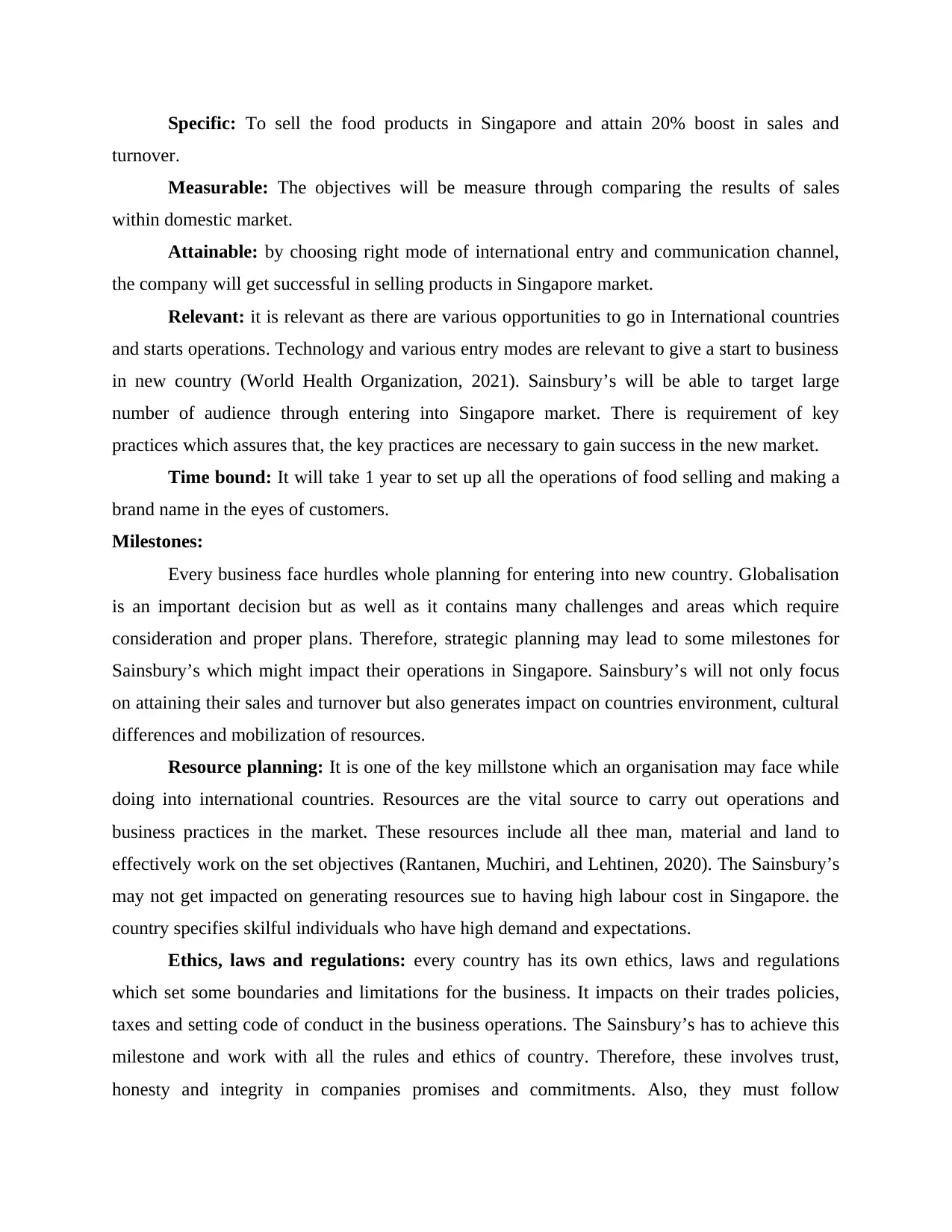
Specific: To sell the food products in Singapore and attain 20% boost in sales and
turnover.
Measurable: The objectives will be measure through comparing the results of sales
within domestic market.
Attainable: by choosing right mode of international entry and communication channel,
the company will get successful in selling products in Singapore market.
Relevant: it is relevant as there are various opportunities to go in International countries
and starts operations. Technology and various entry modes are relevant to give a start to business
in new country (World Health Organization, 2021). Sainsbury’s will be able to target large
number of audience through entering into Singapore market. There is requirement of key
practices which assures that, the key practices are necessary to gain success in the new market.
Time bound: It will take 1 year to set up all the operations of food selling and making a
brand name in the eyes of customers.
Milestones:
Every business face hurdles whole planning for entering into new country. Globalisation
is an important decision but as well as it contains many challenges and areas which require
consideration and proper plans. Therefore, strategic planning may lead to some milestones for
Sainsbury’s which might impact their operations in Singapore. Sainsbury’s will not only focus
on attaining their sales and turnover but also generates impact on countries environment, cultural
differences and mobilization of resources.
Resource planning: It is one of the key millstone which an organisation may face while
doing into international countries. Resources are the vital source to carry out operations and
business practices in the market. These resources include all thee man, material and land to
effectively work on the set objectives (Rantanen, Muchiri, and Lehtinen, 2020). The Sainsbury’s
may not get impacted on generating resources sue to having high labour cost in Singapore. the
country specifies skilful individuals who have high demand and expectations.
Ethics, laws and regulations: every country has its own ethics, laws and regulations
which set some boundaries and limitations for the business. It impacts on their trades policies,
taxes and setting code of conduct in the business operations. The Sainsbury’s has to achieve this
milestone and work with all the rules and ethics of country. Therefore, these involves trust,
honesty and integrity in companies promises and commitments. Also, they must follow
turnover.
Measurable: The objectives will be measure through comparing the results of sales
within domestic market.
Attainable: by choosing right mode of international entry and communication channel,
the company will get successful in selling products in Singapore market.
Relevant: it is relevant as there are various opportunities to go in International countries
and starts operations. Technology and various entry modes are relevant to give a start to business
in new country (World Health Organization, 2021). Sainsbury’s will be able to target large
number of audience through entering into Singapore market. There is requirement of key
practices which assures that, the key practices are necessary to gain success in the new market.
Time bound: It will take 1 year to set up all the operations of food selling and making a
brand name in the eyes of customers.
Milestones:
Every business face hurdles whole planning for entering into new country. Globalisation
is an important decision but as well as it contains many challenges and areas which require
consideration and proper plans. Therefore, strategic planning may lead to some milestones for
Sainsbury’s which might impact their operations in Singapore. Sainsbury’s will not only focus
on attaining their sales and turnover but also generates impact on countries environment, cultural
differences and mobilization of resources.
Resource planning: It is one of the key millstone which an organisation may face while
doing into international countries. Resources are the vital source to carry out operations and
business practices in the market. These resources include all thee man, material and land to
effectively work on the set objectives (Rantanen, Muchiri, and Lehtinen, 2020). The Sainsbury’s
may not get impacted on generating resources sue to having high labour cost in Singapore. the
country specifies skilful individuals who have high demand and expectations.
Ethics, laws and regulations: every country has its own ethics, laws and regulations
which set some boundaries and limitations for the business. It impacts on their trades policies,
taxes and setting code of conduct in the business operations. The Sainsbury’s has to achieve this
milestone and work with all the rules and ethics of country. Therefore, these involves trust,
honesty and integrity in companies promises and commitments. Also, they must follow
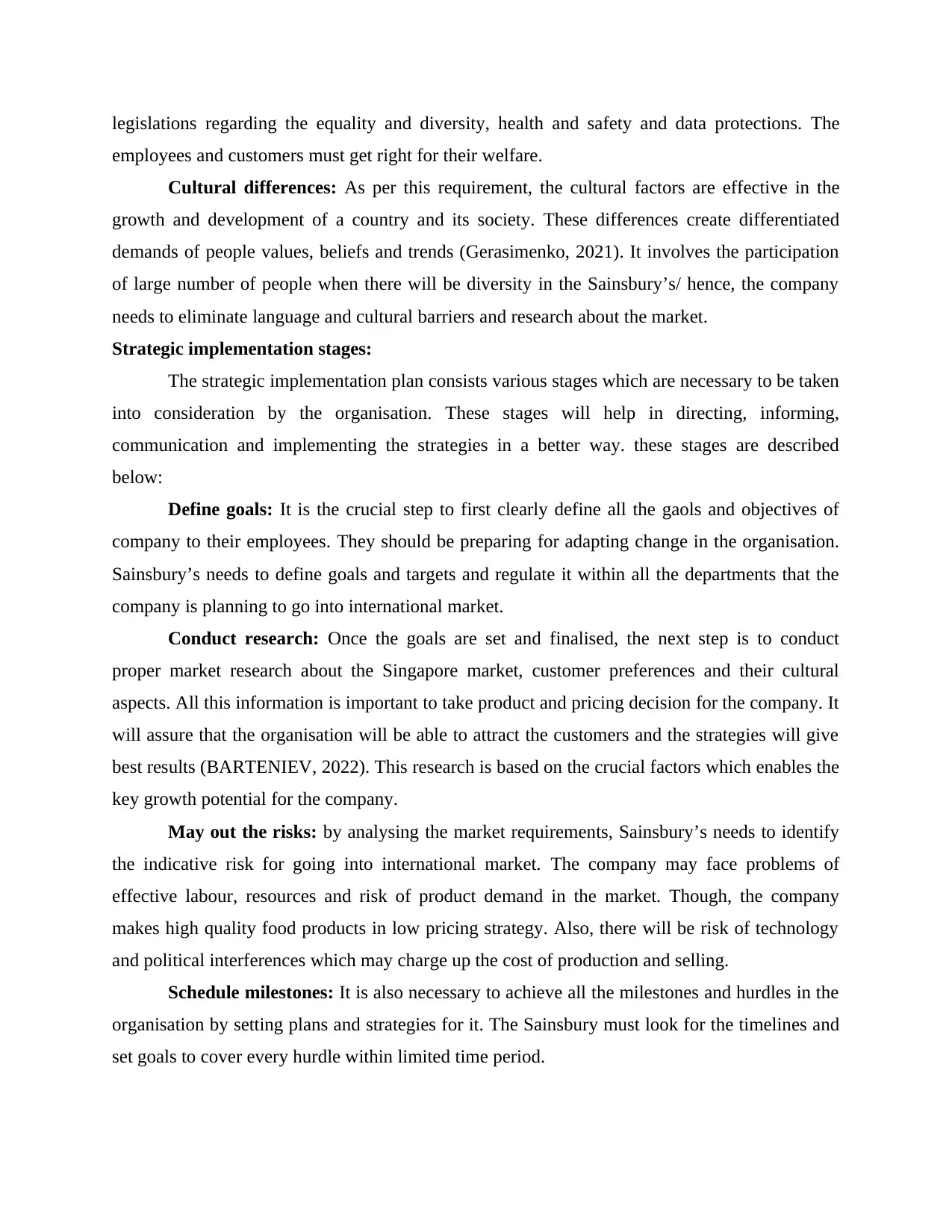
legislations regarding the equality and diversity, health and safety and data protections. The
employees and customers must get right for their welfare.
Cultural differences: As per this requirement, the cultural factors are effective in the
growth and development of a country and its society. These differences create differentiated
demands of people values, beliefs and trends (Gerasimenko, 2021). It involves the participation
of large number of people when there will be diversity in the Sainsbury’s/ hence, the company
needs to eliminate language and cultural barriers and research about the market.
Strategic implementation stages:
The strategic implementation plan consists various stages which are necessary to be taken
into consideration by the organisation. These stages will help in directing, informing,
communication and implementing the strategies in a better way. these stages are described
below:
Define goals: It is the crucial step to first clearly define all the gaols and objectives of
company to their employees. They should be preparing for adapting change in the organisation.
Sainsbury’s needs to define goals and targets and regulate it within all the departments that the
company is planning to go into international market.
Conduct research: Once the goals are set and finalised, the next step is to conduct
proper market research about the Singapore market, customer preferences and their cultural
aspects. All this information is important to take product and pricing decision for the company. It
will assure that the organisation will be able to attract the customers and the strategies will give
best results (BARTENIEV, 2022). This research is based on the crucial factors which enables the
key growth potential for the company.
May out the risks: by analysing the market requirements, Sainsbury’s needs to identify
the indicative risk for going into international market. The company may face problems of
effective labour, resources and risk of product demand in the market. Though, the company
makes high quality food products in low pricing strategy. Also, there will be risk of technology
and political interferences which may charge up the cost of production and selling.
Schedule milestones: It is also necessary to achieve all the milestones and hurdles in the
organisation by setting plans and strategies for it. The Sainsbury must look for the timelines and
set goals to cover every hurdle within limited time period.
employees and customers must get right for their welfare.
Cultural differences: As per this requirement, the cultural factors are effective in the
growth and development of a country and its society. These differences create differentiated
demands of people values, beliefs and trends (Gerasimenko, 2021). It involves the participation
of large number of people when there will be diversity in the Sainsbury’s/ hence, the company
needs to eliminate language and cultural barriers and research about the market.
Strategic implementation stages:
The strategic implementation plan consists various stages which are necessary to be taken
into consideration by the organisation. These stages will help in directing, informing,
communication and implementing the strategies in a better way. these stages are described
below:
Define goals: It is the crucial step to first clearly define all the gaols and objectives of
company to their employees. They should be preparing for adapting change in the organisation.
Sainsbury’s needs to define goals and targets and regulate it within all the departments that the
company is planning to go into international market.
Conduct research: Once the goals are set and finalised, the next step is to conduct
proper market research about the Singapore market, customer preferences and their cultural
aspects. All this information is important to take product and pricing decision for the company. It
will assure that the organisation will be able to attract the customers and the strategies will give
best results (BARTENIEV, 2022). This research is based on the crucial factors which enables the
key growth potential for the company.
May out the risks: by analysing the market requirements, Sainsbury’s needs to identify
the indicative risk for going into international market. The company may face problems of
effective labour, resources and risk of product demand in the market. Though, the company
makes high quality food products in low pricing strategy. Also, there will be risk of technology
and political interferences which may charge up the cost of production and selling.
Schedule milestones: It is also necessary to achieve all the milestones and hurdles in the
organisation by setting plans and strategies for it. The Sainsbury must look for the timelines and
set goals to cover every hurdle within limited time period.
⊘ This is a preview!⊘
Do you want full access?
Subscribe today to unlock all pages.

Trusted by 1+ million students worldwide
1 out of 17
Related Documents
Your All-in-One AI-Powered Toolkit for Academic Success.
+13062052269
info@desklib.com
Available 24*7 on WhatsApp / Email
![[object Object]](/_next/static/media/star-bottom.7253800d.svg)
Unlock your academic potential
Copyright © 2020–2025 A2Z Services. All Rights Reserved. Developed and managed by ZUCOL.



